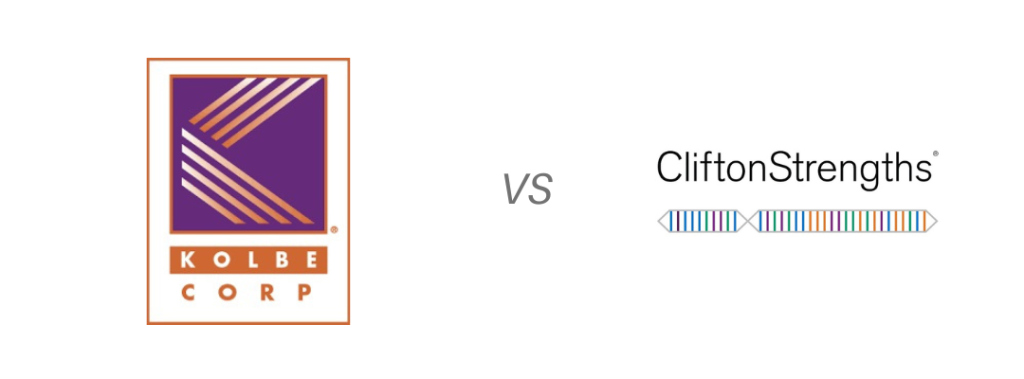Assessment tools are invaluable for understanding individual strengths and fostering team synergy in personal and professional development. Two prominent methodologies in this space are the Kolbe Index and CliftonStrengths, formerly StrengthsFinder.

While both offer insights into innate talents and potential areas of excellence, they approach the concept of personal strengths from different angles.
This article dives deep into the details of Kolbe and CliftonStrengths, comparing their methodologies, applications, and the unique value they bring to individuals and organizations alike.
What is the Kolbe Test?
The Kolbe Test, also known as the Kolbe A™ Index, is grounded in the work of Kathy Kolbe and her studies into the conative aspect of the mind – the part that pertains to spontaneous action. The psychology behind it recognizes that each person has an inborn set of talents and instincts that shape how they tackle challenges and tasks. It taps into what naturally drives one’s behaviors rather than what they know (cognitive) or feel (affective), focusing on the ‘doing’ rather than ‘thinking’ or ‘feeling.’
Origins of Kolbe
Kathy Kolbe founded Kolbe Corp in 1975, and her research gave rise to the test during the 1980s. Her pioneering work identified the part of the brain responsible for instincts and posited that every individual has a unique and innate method of operation.
The test does not measure intelligence, personality, or social style but rather how we act when free to be ourselves. This insight is essential in tailoring work environments to maximize productivity and satisfaction.
Understanding the Psychology
The psychology behind the Kolbe Test theorizes that the conative part of the mind, controlling our instincts, is distinct from our feelings and thoughts. It posits that while cognitive skills and emotions can change over time due to external influences, conative traits are stable throughout one’s life.
Recognizing and harnessing these innate tendencies allows individuals to perform at their best using their intuitive modus operandi rather than going against their natural grain.
Key Concepts
The Kolbe Test divides conative abilities into four essential Action Modes®: Fact Finder, Follow Thru, Quick Start, and Implementor. These modes represent different ways individuals gather and share information, organize, deal with risk and uncertainty, and handle space and tangibles.
Understanding these traits allows for better-aligned job roles, responsibilities, and team dynamics, fostering more effective collaboration and work output.
Action Modes® Explained
- Fact Finder describes how one gathers and processes information. Individuals strong in this mode excel at detailed analysis and thorough investigation.
- Follow Thru indicates how one organizes or seeks structure. Those who score high here are adept at creating order, scheduling, and maintaining systems.
- Quick Start reflects one’s comfort with risk and change. High scorers tend to be innovative and adaptable and often initiate new projects.
- Implementor reveals how one deals with space and tangibles, with high scorers naturally skilled at building, crafting, and using tools.
These four modes combine to guide individuals toward roles and tasks where their instinctive strengths can be most effectively utilized.
When individuals engage in tasks aligned with their innate strengths illustrated by the Action Modes®, satisfaction, and productivity are maximized, as people are more likely to excel in and enjoy activities that resonate with their instinctual preferences.
What is the CliftonStrengths Test?
The CliftonStrengths Test, formerly known as the StrengthsFinder, was developed by Don Clifton to help individuals identify their unique talents. Clifton, a psychologist and the father of strengths-based psychology designed the assessment based on the premise that understanding and developing one’s strengths leads to more extraordinary achievement and success.
CliftonStrengths is a tool that measures the presence of talents in 34 themes, ranging from Achiever and Learner to Strategic and Empathy, which are then cited as one’s most dominant strengths.
The Psychology Behind CliftonStrengths
The psychology behind the CliftonStrengths Test revolves around positive psychology — focusing on growth and potential rather than deficits. The assessment’s development involved identifying themes prevalent among successful individuals across various roles and industries.
These themes were then translated into a language of 34 distinct “talent themes” that describe an individual’s natural patterns of thought, feeling, and behavior.
Core Concepts of CliftonStrengths
Upon completion of the test, an individual is presented with a report of their top talents from the list of 34. The report ranks these talents, usually providing the top five, which are considered the most dominant.
The philosophy of CliftonStrengths emphasizes that these talents when understood and invested in, can become strengths – defined as consistent, near-perfect performances in a given activity.
Application of Identified Talents
Applying the identified talents in one’s personal and professional life is a critical component of the CliftonStrengths approach. Individuals are encouraged to lean into their strengths for growth rather than focusing excessively on improving their weaknesses.
This methodology finds application in various scenarios, including career development, team building, and leadership.
Integration with Other Assessment Tools
While CliftonStrengths is powerful, integrating its insights with other personality and performance assessment tools, such as the Action Modes discussed previously, can create a comprehensive personal development plan.
When individuals and teams unite the understanding of instinctual traits with identified talents, it can lead to unprecedented productivity and job satisfaction.
Comparing Kolbe and CliftonStrengths
The methodologies employed by Kolbe’s and CliftonStrength’s assessments differ fundamentally in their approach to evaluating individual strengths and talents. Kolbe focuses on conation – the cognitive process connected to striving and volition – assessing how people naturally take action in a given situation.
It identifies instinctual methods of operation, recognizing that these instinctive strategies are critical to an individual’s productivity.
Assessment Methodology
Kolbe zeroes in on the automatic patterns of action through a framework known as the Four Action Modes: Fact Finder, Follow Thru, Quick Start, and Implementor. These modes reveal how individuals will approach a task when free to be themselves.
CliftonStrengths, on the other hand, categorizes a person’s tendencies into 34 distinct “talent themes” that represent an individual’s natural patterns of thought, feeling, and behavior. It measures potential strengths in various domains, including Strategic Thinking, Influencing, Relationship Building, and Executing.
Interpretation and Implementation
Once Kolbe’s results are obtained, they highlight the most effective way for a person to tackle tasks without the interference of education, intelligence, or personality. Thus, aligning tasks with one’s natural modus operandi should, in theory, enhance productivity and reduce stress.
CliftonStrengths’ approach is to identify the top talents and develop them into strengths. This approach spurs individuals to deploy these innate abilities to achieve near-perfect performance in activities mounted on a person’s inherent skills.
The most significant difference between the two systems lies in their focus: Kolbe delineates how one does tasks – highlighting the operational aspect of task execution – whereas CliftonStrengths illuminates what one is naturally good at, pushing these talents towards excellence.
Both systems provide a roadmap for personal and professional development but do so under varying facets of human behavior and achievement.
Understanding and applying the results from these assessments in the workplace can empower team crafting, ensuring roles and responsibilities complement each member’s innate abilities. Kolbe can place people in roles where their instinctive problem-solving methods are a benefit.
At the same time, CliftonStrengths will drive individuals to use their most vital talents to lead in their respective roles, resulting in efficient, harmonious teams that excel in their performance.
Pros and Cons of the Kolbe Index
Advantages of Kolbe
Kolbe’s standout advantage is its focus on intuitive strengths, often overshadowed by acquired skills and intellect. By acknowledging the power of innate talent, Kolbe allows individuals to understand and leverage their natural methods of operation.
This insight is particularly beneficial in a team setting wherein each member’s instinctive strengths can be oriented towards a complementary role, enhancing collaboration and productivity.
Another significant advantage is the actionable applicability of Kolbe’s results. Because the assessment yields concrete data about an individual’s instinctual methods, it can be directly applied to various professional tasks.
This specificity helps businesses effectively align roles and responsibilities with each team member’s innate problem-solving abilities, optimizing work processes.
Disadvantages of Kolbe
On the flip side, one disadvantage of Kolbe is the associated cost of the assessment, which might be prohibitive for some individuals or small businesses. Since continuous development and team adjustments are standard, the expenses of retaking the assessments for multiple employees can escalate quickly.
Kolbe assessments also have a limited focus on cognitive and affective aspects, which form a significant part of an individual’s performance in the workplace. This narrow focus can miss out on the wealth of insights offered by a more holistic view of an employee’s capabilities and learning styles, potentially resulting in an incomplete evaluation of a person’s contribution to the team.
Interpretation Challenges
The interpretation of Kolbe’s results may present challenges for some users. Without the proper expertise in Kolbe’s theories and methodologies, the data can be misinterpreted, leading to misapplication in real-world scenarios. Extensive training or hiring a consultant may be required to mitigate this, further increasing the cost and time investment.
Furthermore, while Kolbe’s emphasis on instinct can be a boon, reliance on this alone may lead to undervaluing the importance of learned skills and adaptable intelligence. In a workplace that values growth and education, this could inadvertently minimize the importance of training and development opportunities.
Potential for Over-Specialization
Lastly, a potential drawback is the risk of over-specialization. When team roles are too rigidly defined based on Kolbe’s instinct-based assessments, there’s a danger that employees may be pigeonholed, limiting cross-functional development and flexibility. This can stifle innovation and adaptability, increasingly valuable traits in today’s dynamic business landscape.
Pros and Cons of CliftonStrengths
Advantages of the CliftonStrengths
Comprehensive Approach
CliftonStrengths is renowned for its in-depth approach to assessing an individual’s talents. It analyzes 34 distinct themes to give users a nuanced understanding of their strengths. As a result, individuals gain valuable insights into leveraging their natural abilities in both personal and professional settings.
The comprehensive nature of this tool allows for a detailed and personalized strengths profile, which aids in developing strategic growth plans tailored to each person’s inherent talents.
Research Backing
Extensive research underpins the CliftonStrengths assessment, adding to its credibility. Leveraging decades of data and psychological studies, the tool is built on a solid empirical foundation. This ensures that the insights aren’t just speculative and somewhat grounded in systematic observation and analysis. Regular updates and refinements reflect an ongoing commitment to maintaining the assessment’s relevance and accuracy in the face of evolving workplace trends and challenges.
Employee Engagement and Productivity
Organizations implementing CliftonStrengths often observe increased levels of employee engagement and productivity. By focusing on and cultivating each team member’s innate strengths, the tool inspires individuals to excel in roles that align with their natural talents.
Increased engagement arises as employees feel recognized and valued for their unique contributions. Acknowledging diversity in skills and talents nurtures a positive work environment and can improve team performance and outcomes.
Empowerment of Individuals
CliftonStrengths empowers individuals by affirming their positive traits and offering a language to discuss their capabilities confidently. This empowerment fosters self-awareness, helping individuals to understand not only where they excel but also why.
Armed with this knowledge, they can make informed decisions about career paths, collaborations, and personal development opportunities that will likely lead to success and fulfillment.
Disadvantages of the CliftonStrengths
Cost and Accessibility
The cost of CliftonStrengths can be a barrier for some individuals and organizations. While the assessment promises in-depth insights, the expense may be hard to justify for smaller companies or those with limited budgets for personal development tools.
Additionally, the complexity of using the tool effectively may necessitate training or the hiring of certified coaches, which adds another layer of investment. Access to the full suite of CliftonStrengths’ features and resources may thus be restricted to those who can allocate the resources needed.
Complexity of Interpretation
Another challenge lies in the interpretation of results. CliftonStrengths delivers complex information that requires careful analysis to fully understand and apply effectively.
This complexity may overwhelm some users who lack the training or support to dissect and utilize the depth of information provided. Even with precise results, the onus is on individuals and team leaders to translate strengths into actionable strategies.
Without this translation, the valuable insights could go underutilized, negating many benefits of the in-depth assessment.
Practical Applications and Implications
Personal Development with Kolbe and CliftonStrengths
Kolbe and CliftonStrengths assessments hold significant value for individual self-awareness and personal growth. By highlighting innate talents, both tools enable individuals to hone their natural abilities and channel them productively.
Using CliftonStrengths, a person can identify their top strengths and understand how to utilize them to overcome challenges, improve relationships, and enhance personal and professional development.
On the other hand, Kolbe focuses on individuals’ automatic methods of operation, emphasizing how one organizes, processes, and executes tasks, which can be particularly useful in career planning and achieving personal goals.
Organizational Development
In an organizational context, Kolbe and CliftonStrengths are decisive for team building and employee development. Companies use these assessments to place the right person in the proper role and ensure that teams are balanced with diverse strengths.
Managers and leaders can arrange individuals to complement each other’s talents, facilitating a more cohesive and efficient teamwork dynamic. This insight is critical when assembling project teams, leading change initiatives, or navigating complex workplace challenges.
Maximizing Team Performance
Beyond team composition, these assessments are leveraged to maximize team performance. By understanding and respecting the diverse ways team members operate and contribute, the tools aid in creating an environment that values diverse contributions.
Teams aware of each individual’s strengths can better distribute tasks, communicate more effectively, and reduce friction – for example, assigning someone with a strong ‘Executing’ talent from CliftonStrengths to lead the charge on project implementation while allowing those with ‘Strategic Thinking’ talents to develop the approach and plan.
Employee Engagement and Retention
Furthermore, when employees recognize that their company invests in their strengths and how they naturally do things best, engagement and job satisfaction often increase. This, in turn, leads to higher retention rates as employees feel valued and understood. Engaged employees are also more likely to take initiative and drive innovation within their sphere of influence, becoming invaluable assets to their teams and organizations.
Professional Development and Career Pathing
Both assessments also play a critical role in professional development and career pathing. By evaluating individuals’ natural talents and preferred working styles, HR and talent development professionals can offer more personalized development plans and career advice.
This tailored approach empowers employees and aligns their growth with the organization’s strategic goals, creating a win-win situation.
Companies that embrace such a strengths-based culture tend to have a more committed and competent workforce ready to meet future challenges.
How Accurate is the CliftonStrengths Talent Assessment?
The CliftonStrengths assessment, formerly StrengthsFinder, is grounded in a positive psychology framework. Its accuracy hinges on decades of Gallup research and the responses from millions of individuals.
The assessment offers detailed results, with the chances of having the same Top 5 CliftonStrengths as someone else being 1 in 33 million, suggesting high specificity and personalization. However, like any assessment tool, its accuracy can be affected by the respondent’s self-awareness and the truthfulness of their answers.
The Role of Self-Perception
The CliftonStrengths assessment relies on individuals to self-report, which means the results are as accurate as the individual’s self-perception. Personal bias can skew responses, resulting in a less-than-accurate portrayal of one’s strengths.
For instance, someone might select responses they believe are more socially desirable or reflect who they aspire to be rather than their actual tendencies.
Therefore, the assessment is most accurate when users are candid and reflective about their behaviors and preferences.
Context and Environmental Factors
The context in which the individual operates can also influence the expression and development of their talents. CliftonStrengths highlights potential, but whether that potential is realized may depend on the individual’s environment.
A supportive setting that recognizes and fosters an individual’s strengths will likely validate the assessment’s accuracy. In contrast, a mismatched climate might not allow talents to flourish, creating a perception of inaccuracy in the results.
How Accurate is the Kolbe Assessment?
Measuring Instinctive Strengths
The Kolbe A™ Index is designed to measure an individual’s instinctual methods of operation, which indicate their natural strengths and preferences.
Unlike CliftonStrengths, which focuses on talents that can be nurtured into strengths, the Kolbe Assessment centers on conative faculties – the actions one is naturally inclined to take.
While cognitive assessments measure what you can or can’t do, and affective assessments measure what you like or dislike; the Kolbe Assessment determines how you will naturally tackle tasks when left to your own devices. It does not account for personality or intelligence.
Instead, it uncovers the natural ways you organize and process information, which can be an insightful layer when combined with other personality assessments.
Applicability in Personal and Professional Settings
The Kolbe Assessment’s accuracy is particularly noticeable when applied in real-world settings—both personal and professional.
By understanding their instinctive strengths, individuals can align their tasks and responsibilities according to their innate methods. This alignment plays a significant role in enhancing productivity and workplace satisfaction.
Furthermore, teams can achieve greater synergy by combining members with complementary Kolbe scores, creating a dynamic that effectively leverages diverse strengths.
Adapting to Change
One of the core aspects of the Kolbe Assessment’s accuracy is its consideration of the user’s consistent patterns over time.
While cognitive abilities and interests may fluctuate, conative strengths remain relatively stable. This constancy ensures that Kolbe results retain relevancy and can guide an individual through various phases of life and career, providing a dependable framework for decision-making and stress reduction, especially during times of change.

